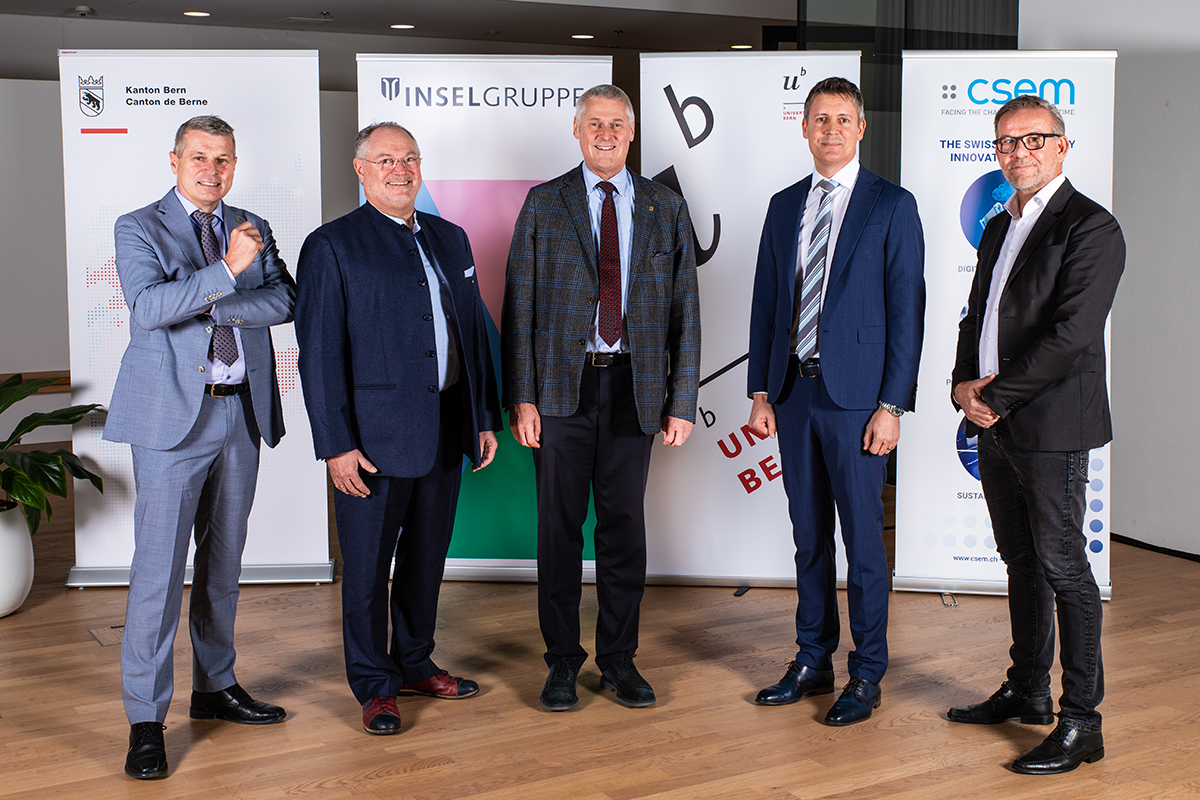Medtech hub in Bern on the way to great success
The canton of Bern wants to establish itself as a leading international medical location by 2030. To achieve this, the Insel Group, the University of Bern, and the technology innovation center, CSEM, will combine their exceptional medical expertise and work together on research and development projects. Their goal is to strengthen the competitiveness of local industrial businesses and start-ups.
Since the decision by the Grand Council of Bern on June 13, 2023 regarding the establishment of a department of the technology innovation center, CSEM, medical and clinical research has been actively promoted on the Insel Campus. Ten new collaboration projects between various university clinics and the University of Bern have been started. In addition to previous work on gynecology, neurology and diabetology, endocrinology, nutrition medicine, and metabolism domains, these new collaborative projects will cover different fields such as, pneumology, cardiology, and surgery. The goal of these projects is to use new measurement technologies and artificial intelligence to make patient care and monitoring easier, and to support medical professionals with diagnostics and therapy optimization.
At today’s media orientation, all four partners – CSEM, the Canton of Bern, Inselspital (University Hospital Bern), and the University of Bern – showcased concrete examples of their past and future collaborations. They confirmed that nearly all medical departments of the Insel Group, along with numerous academic researchers and various start-ups, have expressed strong interest in this collaboration.
The potential benefits to patients
Together with the University Clinic for Pneumology from the Inselspital (University Hospital Bern), CSEM is currently carrying out two studies to make the evaluation and treatment of lung diseases easier and to monitor patients continuously. They are testing a chest strap that can measure pulmonary blood pressure in patients with chronic lung diseases. For patients, this could reduce the need for frequent visits to pulmonary function laboratories. Two more examples from this year’s projects: The University Clinic for Cardiology and CSEM are looking for alternatives to the adhesive electrodes commonly used for monitoring cardiac arrhythmia. The University Clinic for Diabetology, Endocrinology, and Metabolism is exploring together with CSEM if changes in the voice can indicate hypoglycemia (low blood sugar).
2024 overview
Researchers from the University of Bern and Inselspital (University Hospital Bern), submitted new project ideas and research projects for 2024 by mid-October 2023. A panel of 22 medical-technology specialists and experts will decide by the end of November how to allocate the annual research fund of 2 million Swiss Francs. In total, 29 projects have been submitted from almost every medical field. The diversity of the applications shows the high interest in digital solutions in the hospital sector and the success potential at the crossroads of medicine and engineering.
CSEM moved into new premises on the Insel Campus
To better facilitate teamwork, CSEM has procured offices and meeting rooms on the Insel Campus, including some within the Sitem Start-up Club (SSC). Twenty employees have already settled in the new premises and by 2026, CSEM’s "Medtech" department will have about 65 specialists, 43 of whom will be based in Bern.
The Medtech ecosystem in Bern is already bearing fruit
The collaboration between renowned institutions from Bern and CSEM has existed for several years and has led to several successful projects, including the 2019 machineMD start-up in Bern. This spin-off from the Inselspital (University Hospital Bern), and the University of Bern uses virtual-reality glasses for a complete, standardized neuro-opthalmological exam to improve the diagnosis and monitoring of neurological diseases. In addition to CSEM, specialists and experts from the Swiss Federal Institute of Technology in Bern and the Helbling Group also contributed to the project. This example shows the potential of the Swiss innovation landscape when different stakeholders work together.
Existing collaboration working as a catalyst
Cooperating with several university clinics (gynecology, neurology, diabetology, endocrinology, nutrition medicine, and metabolism) has led to concrete success in recent years: a lightweight, wearable electrode belt around the abdomen for better monitoring of pregnant women and their babies before and during birth; two wearable systems for continuous day and night monitoring of people with epilepsy through a pair of electrodes discreetly attached to glasses frames for the daytime and integrated into a headband for nighttime; and smartphone voice recordings that could play a significant role in the treatment of diabetes patients. All examples have come from the intersection of "microelectronics and prototyping" and "medical and clinical research".
Source: CSEM
2023/11/06

